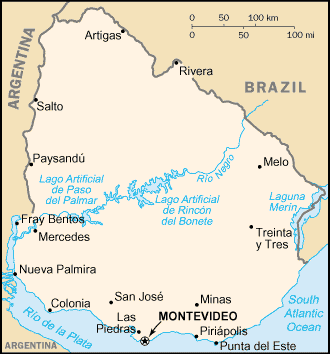Capital: Montevideo
Population: 3.4 million (UN, 2003)
Year of Independence: 1825, from Brazil
Type of Government: Constitutional Republic
GNP: $31 billion (2001 est.)
Natural Resources: arable land, hydropower, minor minerals, fisheries
Political Parties: Colorado Party; National Party (Blanco); New Sector/Space Coalition (Nuevo Espacio); Progressive Encounter/Broad Front Coalition (Encuentro Progresista/Frente Amplio)
The windswept grasslands and alluring beaches of Uruguay have made it a hot spot for South American tourists and allowed it to ease its dependence on agricultural land. Although lacking in natural resources such as oil (except for its mineral deposits of bauxite, marble, and granite), an agricultural-pastoral economy coupled with high activity in industrialization has allowed Uruguay to remain relatively economically stable. It boasts the lowest poverty rate in the region and a model welfare state system that seeks to care for its comparatively high population of the aged. Recent difficulties with this healthcare system and a lack of trading partners on the international scale have added to Uruguay’s concerns over its neighboring countries’ crises. Guerilla movements prompted the military to take over the government during the 1960s and the 1970s. In 1985, the country returned to civilian rule after the military lost power in the early 1980s. The current president, Jorge Batlle Ibañez, faces political and social upheaval, a heritage of the civil rights violations committed during the decades of military rule, as well as troubles with the economy.



